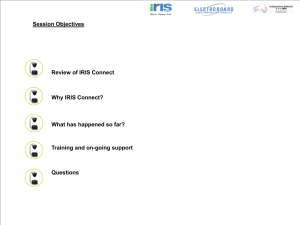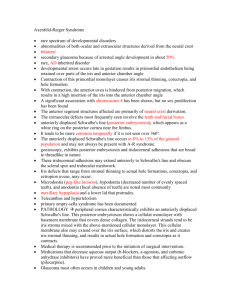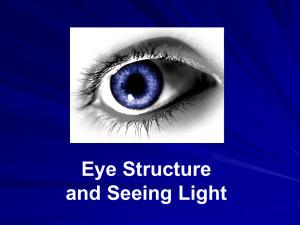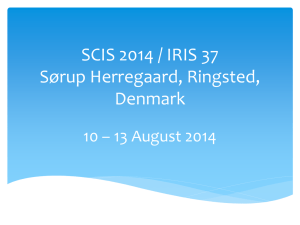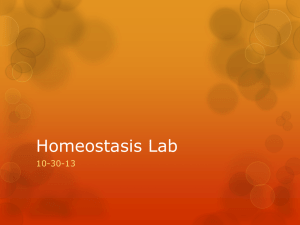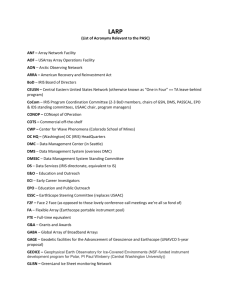IriTech`s Core Algorithms
advertisement
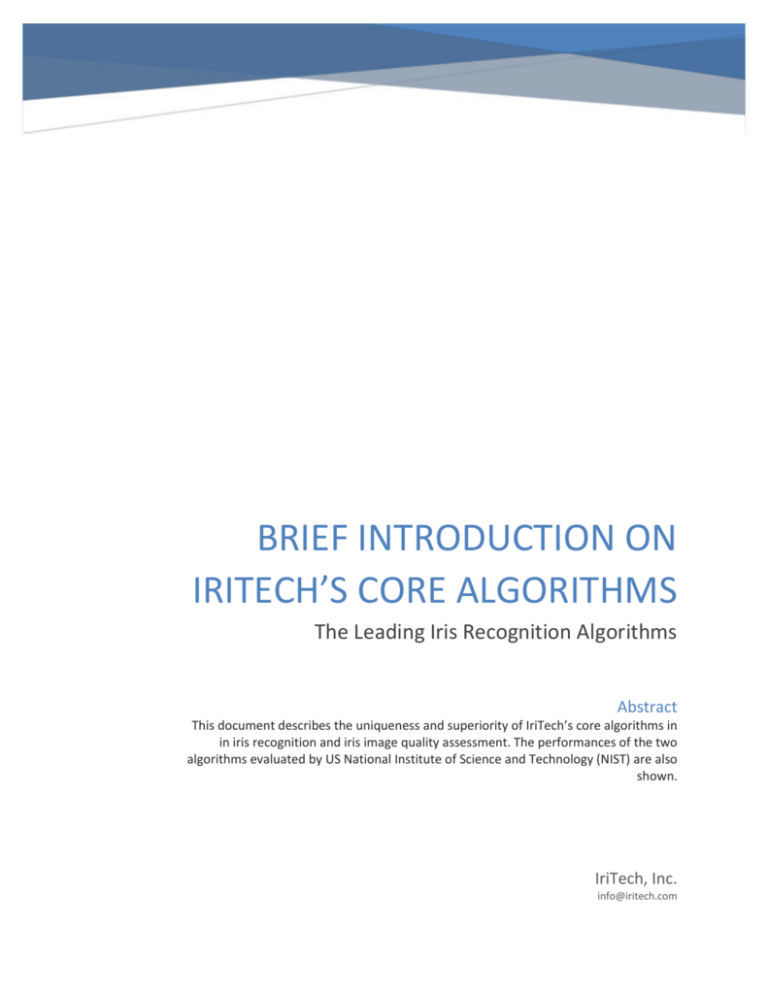
BRIEF INTRODUCTION ON IRITECH’S CORE ALGORITHMS The Leading Iris Recognition Algorithms Abstract This document describes the uniqueness and superiority of IriTech’s core algorithms in in iris recognition and iris image quality assessment. The performances of the two algorithms evaluated by US National Institute of Science and Technology (NIST) are also shown. IriTech, Inc. info@iritech.com Brief Introduction of IriTech’s Core Algorithms 1 SUPERIOR IRIS RECOGNITION ALGORITHM Almost all known iris technology vendors, except IriTech, use variants of Daugman method one way or another. IriTech’s algorithm is better than the others in the sense that it is more robust to pupil dilation/constriction, segmentation error, occlusion, and image blurriness. Since iris muscles control the size of the pupil, iris pattern shown in a captured iris image deforms significantly during pupil dilation/constriction. Daugman-based approaches assume the iris deformation is linear when mapping the iris to the polar rectangular format. However, iris deformation is not linear and in fact differs from person to person. To cope with the non-linear iris deformation, IriTech uses its patented “Variable Multi-sector Analysis” method, where the whole iris is divided into several sectors and local deformation of each sector is analyzed separately to obtain the correct sector combination for matching. Such local deformation analysis makes IriTech’s matching algorithm not only resilient to various iris deformation laws but also tolerant to a-few-pixel error in image segmentation (i.e., pupil and iris border detection). The segmentation error tolerance is important since the pupil and iris boundaries are not perfectly circular or elliptical as assumed by most iris recognition algorithms. The variable multi-sector method also facilitates (together with the occlusion detection itself) the rejection of contaminated sectors that are occluded by eyelids, eyelashes, or LED reflection. Those unclean parts once used usually lead to matching errors. IriTech’s matcher can provide accurate matching results with only 30% of the iris area required to be clean. IriTech’s algorithm is also more resilient to blurry images. Conventional technology often uses some type of frequency transform for template generation. If the image is blurry, many high-frequency components will be lost or inaccurately found. On contrary, by utilizing a judicious mixture of low to mid frequencies, IriTech’s technology has a much smaller chance of losing frequency components necessary for template generation. With the aforementioned characteristics, IriTech’s iris SDK was proven as the most accurate and interoperable algorithm by NIST report [1]. As shown in Fig. 1, the error rate (Generalized False Reject Rate) of the second best SDK is more than two and half times larger than that of IriTech. What is more remarkable is that the DET curves of IriTech’s SDKs are basically horizontal, which is the sign of extreme stability and applicability to large datasets. The interoperability test, where NIST evaluated how each SDK performed on standard IREX records (K3, K7, and K16) generated by itself and by others, can be concluded as “From the "wins" row of Tables 12, 13, and 14, the [IriTech] I1 and I2 matchers are the most capable of matching IREX records regardless of their source. The false non-match rates are less than half of other matchers.” ( [1] page 76) Copyright ©2012, IriTech, Inc. 1 Brief Introduction of IriTech’s Core Algorithms IriTech’s SDK Fig. 1. IREX I accuracy testing result on OPS dataset (Figure 10 of NIST report [1], ©NIST). IriTech’s SDK outperformed the others, with two and a half times smaller false reject rate than that of the second best SDK. Since IREX I, IriTech has been continuously improving its algorithm in both accuracy and speed. The accuracy improvement computed on the publicly available BATH dataset is shown in Fig. 2, where it is superimposed on Figure 11 of NIST report [1] for easy comparison. IriTech’s IREX I SDK Fig. 2. Improvement of IriTech’s latest SDK compared to those in IREX I on the BATH dataset. The speed of IriTech’s latest algorithm measured on a PC (Intel Core i7, 6 cores, 3.33 GHz, 12GB RAM) is as follows. - Template generation speed: 8.42 templates/ sec/ core. - Template matching speed: 293,000 matches/ sec/ core (for 1:1 matching) 388,000 matches/ sec/ core (for 1:N matching). Copyright ©2012, IriTech, Inc. 2 Brief Introduction of IriTech’s Core Algorithms 2 POWERFUL IMAGE QUALITY ASSESSMENT The assessment of iris image quality is useful in almost all stages of an iris biometric system. During image acquisition, it can be used for real-time selection of the best frame of the streaming video from the camera sensor. During enrollment, it can provide feedback for the operation to e.g., re-capture the subject’s iris image if it is not good enough. For verification/identification, quality score can help to predict the resulting matching accuracy and accordingly give actionable feedbacks. Realizing such importance, IriTech has long been developing extensive and superior algorithm for measuring the quality of iris image. Its quality assessment algorithm provides all quality metrics defined by NIST IREX II – IQCE (see TABLE 1) together with its self-defined metrics such as texture or usable lowerhalf iris area. TABLE 1. QUALITY METRICS DEFINED BY NIST IREX II (IQCE). IQCE Quality Metrics Description 1 Scalar quality The overall quality score, combining all IQCE and vendor-defined metrics 2 Gray level spread The extent of proper exposure 3 Iris size Iris radius in pixel 4 Pupil iris ratio Ratio of pupil radius to iris radius 5 Usable iris area 6 Iris-sclera contrast Percentage of iris that is not occluded by eyelash, eyelid, specular reflections, etc. The contrast between iris and sclera at their boundary 7 Iris-pupil contrast The contrast between iris and pupil at their boundary 8 Iris shape The extent of non-circularity of iris-sclera boundary 9 Pupil shape The extent of non-circularity of iris-pupil boundary 10 Margin 11 Sharpness The degree to which the iris position relative to the edges of the image violates the margin requirements of ISO/IEC 19794-6 The absence of defocus blur 12 Motion blur The extent of blurriness caused by the motion of the camera or the iris, or both 13 Signal to noise ratio The extent of the sensor noise 16 Gaze angle The deviation between optical axis of the subject’s iris and that of the camera 17 Interlace The extent of artifact caused by interlacing acquisition model Among all IQCE metrics, usable iris area has the greatest influence on the matching accuracy. However, due to its nature of matching algorithm, IriTech additionally defines the usable lower-half iris area, which provides a better indication once coupled with the IQCE usable iris area. Some samples of those are shown in Fig. 3 and Fig. 4. Copyright ©2012, IriTech, Inc. 3 Brief Introduction of IriTech’s Core Algorithms Fig. 3. Sample images with IQCE’s usable iris area values = 100, 92, and 65 (from left to right). Fig. 4. Sample images with IriTech’s usable lower-half iris area values = 100, 90, and 82 (from left to right). Similarly, while the IQCE sharpness is a very good indicator of the global image quality, it lacks of the local information of the iris, which is among the most important factors for accurate matching. Most iris cameras tend to focus on high spatial energy, typically eyelashes or cosmetic mascara, but not the iris itself. As a result, although the overall image looks sharp, the iris texture may be blurry. Therefore, IriTech defines another supplemental quality metric, called texture, to measure the defocus of the usable iris region. Some samples of texture values are shown in Fig. 5. Fig. 5. Sample images with IriTech’s texture values = 94, 57, and 31 (from left to right). Combining all IQCE metrics with its self-defined ones, IriTech provides a scalar overall quality, which was evaluated by IREX II [2] as the best indicator of the image quality for operational images. The performance of this scalar quality measurement is evaluated mainly by how quickly FNMR (false non-match rate) improves when poor quality samples (the scalar quality is smaller than a certain threshold) are rejected. For fair comparison, FNMR is computed using matchers of all vendors. As shown Fig. 6, regardless of which matcher (comparison score) is used, IriTech’s FNMR decreases almost the fastest as the rejection rate increases. For more details, see IREX II final report found in [2]. The superiority of IriTech’s scalar quality measure algorithm was re-affirmed with a large-scaled data set (1.6 million) by IREX III final report ( [3], page 87). Copyright ©2012, IriTech, Inc. 4 Brief Introduction of IriTech’s Core Algorithms Fig. 6. Quality evaluation curve: False non-match rate vs. scalar quality-based rejection rate. For almost all the matchers (comparison scores) used, IriTech’s curves (green color) are the best (the lowest). “E2a [IriTech] is the best performer, followed by Hx and F1.” (from figure 13, page 56, IREX II report) Copyright ©2012, IriTech, Inc. 5 Brief Introduction of IriTech’s Core Algorithms 3 ABOUT IRITECH, INC. IriTech is a US corporation headquartered in Fairfax, Virginia with a regional office in Seoul, Korea. The company provides a full range of iris technology to government agencies, biometric device manufacturers, system integrators, and OEM product developers. IriTech’s top-notch technology and collaborative spirit have made it the de facto key enabling company in the iris biometrics business. Pioneer in introducing top quality and low cost iris cameras Best matching algorithm proven by NIST IREX Unique original algorithm inventor with over fifty patents End-to-end solution provider IriTech’s software successful implemented in US-VISIT pilot program Selected as one of the biometrics solution providers for India’s UID Project, the largest national biometrics project in the world Strategic partnerships with Lockheed Martin and Texas Instruments Past and current participation in a number of national ID and governmental projects with foreseeable expansion to private industries, including commerce and banking. 4 REFERENCES [1] NIST IREX I Report. [Online]. http://biometrics.nist.gov/cs_links/iris/irex/irex_report.pdf.zip [2] NIST IREX II. [Online]. http://www.nist.gov/itl/iad/ig/irexii.cfm [3] NIST IREX III Report. [Online]. http://biometrics.nist.gov/cs_links/iris/irexIII/IREXIII_full.zip Copyright ©2012, IriTech, Inc. 6



